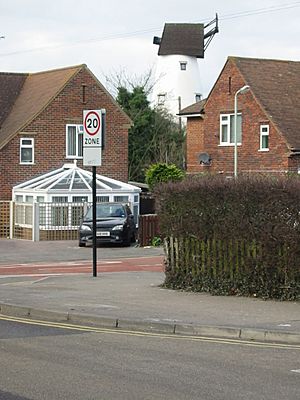Mills in Canterbury facts for kids
The city of Canterbury in Kent, England has had many mills over hundreds of years. These important structures used different kinds of power. They included animal engines, watermills, and windmills.
Contents
Mills Powered by Animals
A very old and special type of mill is the treadwheel. This machine was powered by animals or even people walking inside a large wheel. One rare treadwheel still exists today. You can find it in the Bell Harry tower of Canterbury Cathedral. It shows how people used to power machines before electricity.
Watermills Along the River Stour
Watermills use the power of flowing water to turn their machinery. In Canterbury, there were once ten different watermills. They were all built at various times along the Great Stour river. These watermills helped with many tasks, like grinding grain into flour. You can find more details about them in the article about the Stour watermills.
Canterbury's Windmills
Windmills use the power of the wind to turn large sails. These sails then power machinery inside the mill. At least six different windmills are known to have stood in Canterbury over time.
St Martin's Mill
St Martin's Mill is a type of mill called a tower mill. It was built in 1817 and worked until 1890. A tower mill has a tall, round stone or brick tower. The cap (top part) of the mill, which holds the sails, can turn to face the wind. Today, St Martin's Mill has been changed into a house.
St Martin's Black Mill
St Martin's Black Mill was a smock mill. This type of mill has a wooden frame that looks like a smock (a type of shirt). It usually sits on a brick base. This mill was shown on old maps from the early 1800s. It was taken down in 1868. Its sails and main parts were moved to a new mill in Blean. This mill had three stories on top of a two-story base. It used a special tail fan, called a fantail, to automatically turn the cap into the wind.
St Lawrence Mill
St Lawrence Mill was also a smock mill. It appeared on maps from the early 1800s. Sadly, this mill burned down on May 15, 1873. Millers like Richard Fuller and J Chantler worked there in the mid-1800s. This mill was built near where Canterbury's very first windmill stood. That first mill was built in the 1200s.
Dane John Mill
Dane John Mill was a post mill. In a post mill, the entire body of the mill, which holds all the machinery, can turn on a large central post. This allowed the miller to turn the whole mill to face the wind. This mill was advertised for sale in 1731. It was rebuilt in 1790 by James Simmonds. John Parker was the miller there in 1839.
Franciscan Gardens Mill
A smock mill was shown in a picture from 1846 in the area known as the Franciscan Gardens. This shows that mills were an important part of the landscape.
St. Thomas' Hill Mill
Another mill was located on St. Thomas' Hill. This mill appeared in pictures from 1816, 1835, and 1856. John Goble or Gobell was the miller at this location in 1839.


